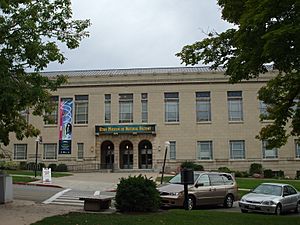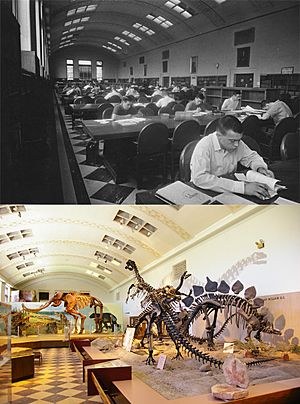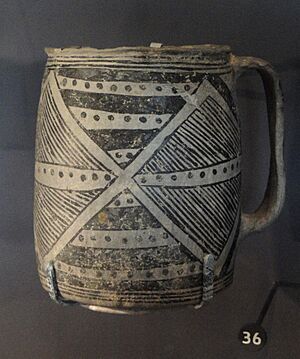Natural History Museum of Utah facts for kids

The Rio Tinto Center, home of the museum since 2011
|
|
| Established | 1969 |
|---|---|
| Location | 301 Wakara Way, Salt Lake City, Utah |
| Type | Natural history |
| Visitors | About 250,000 annually |
The Natural History Museum of Utah is an exciting museum in Salt Lake City, Utah, USA. It shows amazing exhibits about the natural history of our world, especially focusing on Utah and the nearby Intermountain West region. The museum's main goal is to help people understand the natural world and how humans fit into it.
In November 2011, the museum moved into a cool new building called the Rio Tinto Center. It's part of the University of Utah and is located in the university's Research Park.
Contents
How the Museum Started
The idea for the museum began in 1959. A group of professors at the University of Utah decided to bring together all the natural history collections from different parts of the campus. The museum officially started in 1963, named the Utah Museum of Natural History.
In 1969, the museum opened its doors to the public. It was located in the old George Thomas Library building. It included items from other older museums, like the Deseret Museum.
Discovering Dinosaurs
During the 1960s, the museum's collection of paleontology (the study of fossils) grew a lot, especially with dinosaur fossils! This exciting time began when a young paleontologist named James Henry Madsen Jr. finished his studies at the University of Utah in 1959.
In 1960, Madsen started working with Professor William Lee Stokes from Princeton University. They were working on a huge project to dig up fossils at the Cleveland-Lloyd Dinosaur Quarry. This quarry is one of the most important fossil sites ever found in the United States.
Even in the early 1960s, thousands of dinosaur bones were still buried there. Most of these bones were from the Allosaurus fragilis dinosaur. Because there were so many bones, Stokes and Madsen realized one museum couldn't dig them all up alone.
So, they created the University of Utah Cooperative Dinosaur Project. The University of Utah helped fund this project. For 16 years, the project worked with museums and research centers from all over the world. In return for their help, these institutions received casts or even real dinosaur specimens.
Amazing Dinosaur Finds
From 1960 to 1976, tons of fossilized bones were dug up from the quarry. They found remains of famous dinosaurs like Camarasaurus, Camptosaurus, Ceratosaurus, Stegosaurus, and Allosaurus. Allosaurus was the most common, with bones from 44 to 46 different individuals found!
They also discovered and named two new dinosaur species: Stokesosaurus (in 1974) and Marshosaurus (in 1976). The very first examples of these dinosaurs (called holotypes) are kept at the Natural History Museum of Utah.
The University of Utah Cooperative Dinosaur Project ended in 1976. However, thanks to this project and Madsen's work, the Natural History Museum of Utah now has the largest collection of Allosaurus skeletons in the world! They also have skeletons of other dinosaur species.
Museum Leadership and New Home
In 1963, Dr. Jesse D. Jennings, an archaeologist, became the museum's first director. He led the museum for 10 years after it opened to the public in 1969.
Don Hague, who was the museum's first paid employee, became director in 1973. He guided the museum for almost 20 years until he retired in 1992.
Dr. Sarah George was the director for 27 years, from 1992 to 2019. Since March 2020, Dr. Jason Cryan has been the museum's fourth executive director.
In 2011, the museum moved from its old location to the Rio Tinto Center. This new building is in the University of Utah's Research Park. When it moved, the museum also changed its name to the Natural History Museum of Utah.
The Rio Tinto Center is a huge building, about 163,000 square feet (15,143 square meters). It sits on a 17-acre (6.9-hectare) campus in the foothills of the Wasatch Mountains. The building has a unique round structure on its back side, which holds the Native Voices gallery.
Collections and Research
The Natural History Museum of Utah has over 1.65 million objects! These items are used for research and education. The collections mostly focus on the natural history of Utah. Researchers from all over the world can access them. Most of the items come from public lands in the western United States.
These collections help scientists study the variety of geological features, biological life, and cultural history in Utah. The museum aims to grow its collections and make this information available to as many people as possible.
The museum has a million objects related to anthropology, which is the study of human societies and cultures.
- About 750,000 objects are from archaeological digs.
- There are records from over 3,800 different sites.
- The ethnographic collection, which includes items from different cultures, has over 2,000 objects.
The paleontology collection includes 12,000 vertebrate fossils (like bones), 4,000 invertebrate fossils (like shells), and 7,000 plant fossils. The entomology collection (insects) has 140,000 specimens. The vertebrate zoology collection includes 30,000 mammals, 20,000 birds, and 18,000 reptiles. The mineralogy collection has 3,700 minerals. The botany collection (plants) has 123,000 specimens. The malacology collection (shells and mollusks) has 25,000 specimens.
Permanent Exhibitions
The museum has ten amazing permanent exhibitions for you to explore:
- Past Worlds
- Great Salt Lake
- Life
- Land
- First Peoples
- Gems and Minerals
- Native Voices
- Our Backyard
- Utah Futures
- Climate of Hope
The museum also has a special gallery that features different rotating exhibitions throughout the year.
Educational Programs
The museum's Education & Community Engagement Department organizes many fun and educational programs. These programs are often connected to what students learn in school.
- Self-Guided and Partner Field Trips: Students can explore the museum in groups with chaperones.
- Junior Science Academy: Classes for fourth- and fifth-grade students held at the museum, linked to their school lessons.
- Child and Family Programs: After-school, Saturday, and summer classes for kids in grades K-6, covering natural history and science topics.
- Adult Programs: Workshops, lectures, and special events for grown-ups.
Reaching Out to the Community
The museum also has programs that reach out beyond its walls:
- Museum on the Move: Museum educators visit fourth-grade classrooms across the state to teach about five different topics.
- Teaching Toolboxes: Teachers can borrow special boxes filled with teaching materials for two weeks.
- Youth Teaching Youth: This program works with Glendale Middle School. Middle school students learn to teach elementary school classes using special kits. These middle schoolers lead all classroom outreach in the Salt Lake School District. As they get older, they can even get internships at the museum or university!
- Traveling Treasures: These are collections that travel to different locations.
- Teen Explainers: This is a paid internship program for high school students. They learn about museums and communication. Teen Explainers help museum visitors learn through interactive activities.
The Museum's Role at the University of Utah
The museum is an important part of the academic life at the University of Utah. Its collections offer great research opportunities and act as a learning laboratory for students. Museum programs teach students about many parts of museum work, like designing exhibits, public relations, and creating educational materials.
The museum stores collections that were gathered by the university's Anthropology, Biology, and Geology departments. These collections are available for faculty, graduate students, and undergraduates to use for research and teaching.
The museum also offers training for public school teachers. Teachers can earn university credit for these courses, which can help them advance in their careers. The museum also partners with the university's Genetic Science Learning Center for teacher training.
The museum's meeting rooms can be rented by groups from both the university and the public.




